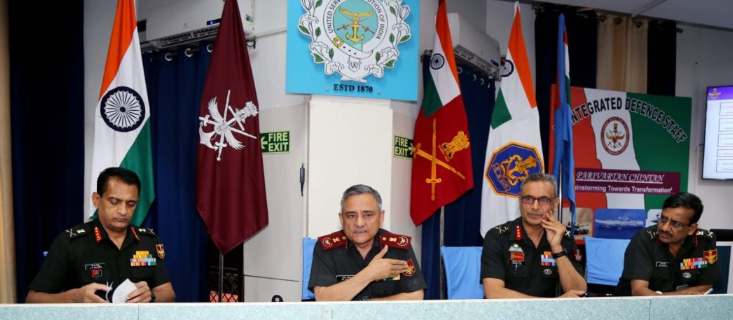Parivartan Chintan (GS Paper 3, Defence)

Context
- The Tri-service Conference, ‘Parivartan Chintan’, was held in New Delhi.
About
- The ‘Chintan’ was curated as a brainstorming and idea incubation discussion to generate new and fresh ideas, initiatives and reforms to further propel Jointness and Integration in the Armed Forces.
- Jointness and Integration are the cornerstones of the transformation to Joint Structures which the Indian Armed forces are progressing towards with the intention of being “Future Ready”.
Theatre Command
- A theatre command deploys elements of the three services i.e. the Indian Army, Indian Navy, and Indian Air Force under a single, unified command structure.
- Each command is assigned a specific geographical region, combining resources of the three services for operational roles.
- There will be two land-based commands—one focused on Pakistan and the other on China—and a third maritime one, overseeing the Indian Ocean Region.
- The three theatre commands that will be set up first are likely to be located in Jaipur, Lucknow and Karwar.
- Creation of theatre commands and their structure has been under discussion for three years now.
Need for the Theatre Command
- Hostile Neighborhood: The main threat is from China, which works in collaboration with Pakistan. A two-front war is, therefore, a distinct possibility for India.
- The prospect of high technology, multi-domain warfare where adversaries are nuclear-armed requires a swift and dynamic response.
- Optimal use of Resources: The forces will be able to pool their resources efficiently, resulting in the optimum utilisation of platforms, weapon systems, and assets.
- This will also prevent resources from being allocated for duplicate purchases for the three services.
- Help in Logistics: Theatre commands, in the long run, could also improve logistics management in the forces.
- Better Coordination: Currently, India’s multiple military commands are all located in different geographical areas. This, at times, causes communication hindrances during joint operations and exercises.
- With a unified command structure, these communication processes could be simpler and more efficient.
- In Practice in other Nations: Armed forces of major military powers, including the United States, the United Kingdom, Russia, China and France all operate under theatre commands.
- Efficient Planning: Further, in the realm of policy, having a unified command structure with representatives from all three services will also lead to more efficient planning for both peacetime and wartime strategies.
Challenges in Implementation
- Difference of opinion among three forces: There are differences among the three forces on scope, structure, and control of the commands.
- Transfer of Resources: There is a contention on the kind of war-fighting equipment that will be deployed under a single command and ambiguity surrounding the transfer of weapons, platforms, and resources from one theatre command to another.
- Curriculum Framework: In terms of preparing the educational bedrock for military personnel to serve in theatre commands, the country seems to be behind the curve.
- Lack of NSS: Many retired military professionals have criticised implementing theatre commands without having a coherent National Security Strategy (NSS).
- Theatre commands will not have a clear blueprint and policy objective to work towards without an NSS.
Conclusion
- India is moving towards implementing its biggest military overhaul, which could be a force multiplier, a few institutional and ideational changes will have to be incorporated to find the correct balance in such a transformation.
- Given the threat India faces on its northern and western borders, integrated theatre commands and the roles assigned will be key in dealing with any future conflict.


